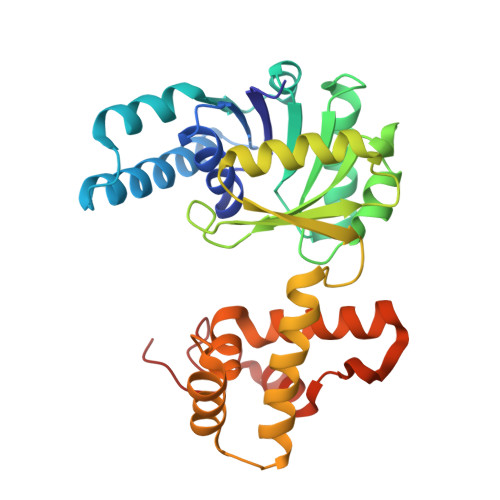Crystal structure and biochemical properties of the (S)-3-hydroxybutyryl-CoA dehydrogenase PaaH1 from Ralstonia eutropha
Kim, J., Chang, J.H., Kim, K.J.(2014) Biochem Biophys Res Commun 448: 163-168
- PubMed: 24792376
- DOI: https://doi.org/10.1016/j.bbrc.2014.04.101
- Primary Citation of Related Structures:
4PZC, 4PZD, 4PZE - PubMed Abstract:
3-Hydroxybutyryl-CoA dehydrogenase is an enzyme involved in the synthesis of the biofuel n-butanol by converting acetoacetyl-CoA to 3-hydroxybutyryl-CoA. To investigate the molecular mechanism of n-butanol biosynthesis, we determined crystal structures of the Ralstonia eutropha-derived 3-hydroxybutyryl-CoA dehydrogenase (RePaaH1) in complex with either its cofactor NAD(+) or its substrate acetoacetyl-CoA. While the biologically active structure is dimeric, the monomer of RePaaH1 comprises two separated domains with an N-terminal Rossmann fold and a C-terminal helical bundle for dimerization. In this study, we show that the cofactor-binding site is located on the Rossmann fold and is surrounded by five loops and one helix. The binding mode of the acetoacetyl-CoA substrate was found to be that the adenosine diphosphate moiety is not highly stabilized compared with the remainder of the molecule. Residues involved in catalysis and substrate binding were further confirmed by site-directed mutagenesis experiments, and kinetic properties of RePaaH1were examined as well. Our findings contribute to the understanding of 3-hydroxybutyryl-CoA dehydrogenase catalysis, and will be useful in enhancing the efficiency of n-butanol biosynthesis by structure based protein engineering.
Organizational Affiliation:
School of Life Sciences, KNU Creative BioResearch Group (BK21 Plus Program), Kyungpook National University, Daehak-ro 80, Buk-ku, Daegu 702-701, Republic of Korea.















